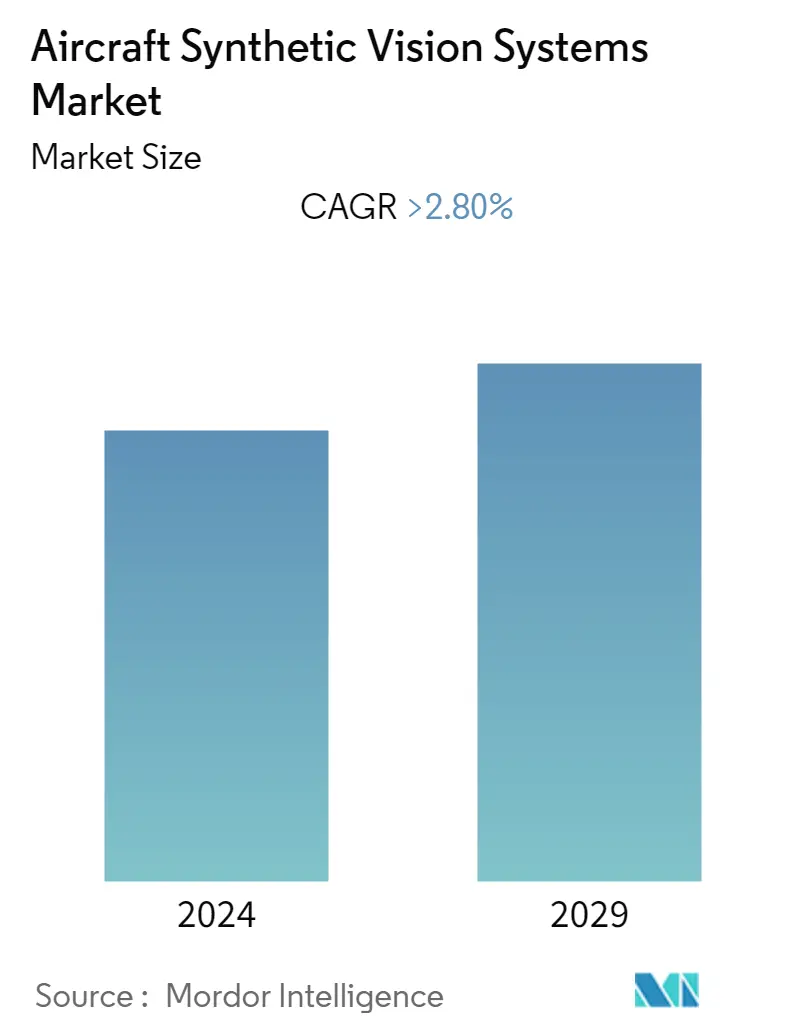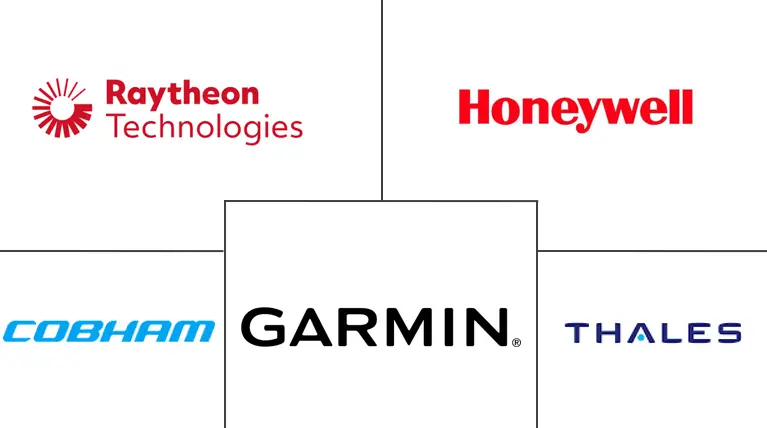Market Size of Aircraft Synthetic Vision Systems Industry

| Study Period | 2019 - 2029 |
| Base Year For Estimation | 2023 |
| CAGR | 2.80 % |
| Fastest Growing Market | Asia Pacific |
| Largest Market | North America |
| Market Concentration | Medium |
Major Players
*Disclaimer: Major Players sorted in no particular order |
Aircraft Synthetic Vision Systems Market Analysis
The aircraft synthetic vision systems market is expected to register a CAGR of 2.8%.
The global aviation sector was disrupted due to the COVID-19 pandemic. However, the sector recovered in 2021 and 2022. Due to the Covid-19 pandemic, the commercial aviation sector has been significantly affected, resulting in a drastic reduction in passenger traffic, negatively affecting aircraft demand. The military aviation sector remained stable and even grew as most countries have not reduced their defense budget and remain committed to sustaining their military capabilities. Nevertheless, due to the widespread supply chain disruption, some military aircraft programs faced minor cost escalations and delays.
The increasing demand for new aircraft drives the synthetic vision systems market as part of the fleet expansion and modernization programs initiated by respective end-users in the military, commercial, and general aviation sectors. Such factors will drive the market in the coming years.
Aircraft Synthetic Vision Systems Industry Segmentation
The aircraft synthetic vision system is an aircraft installation designed to improve the flight crew's situational awareness by combining 3D data into intuitive displays even in low visibility conditions using moving maps, artificial vision, and route planning hardware and software. The system also presents a computer-generated view of the external environment with a database of relevant information about the terrain, flight plan information, and runways to reduce the probability of an accident caused due to loss of control, runway incursion, and CFIT.
The Aircraft Synthetic Vision Systems Market is segmented based on Type, End-user, and Geography. By Type, the market is segmented into Primary Flight Displays, Navigation Displays, Heads-up and Helmet-mounted Displays, and Other Types. By End User, the market is segmented into Military, Commercial, and General Aviation, and by Geography into North America, Europe, Asia-Pacific, Latin America, and Middle East and Africa.
The report also covers the market sizes and forecasts for the aircraft synthetic vision system across major regions. For each segment, the market sizing and forecasts have been done based on value (USD Billion).
| By Type | |
| Primary Flight Display | |
| Navigation Display | |
| Heads-up and Helmet-mounted Display | |
| Other Types |
| By End User | |
| Military | |
| Commercial | |
| General Aviation |
| Geography | |||||||
| |||||||
| |||||||
| |||||||
| |||||||
|
Aircraft Synthetic Vision Systems Market Size Summary
The aircraft synthetic vision systems market is poised for steady growth, driven by the increasing demand for new aircraft across military, commercial, and general aviation sectors. The recovery of the global aviation industry post-COVID-19 disruptions has been a significant factor, with the military aviation sector showing resilience and growth due to sustained defense budgets. The need for advanced military assets, spurred by geopolitical tensions, has led to increased defense spending and procurement of new-generation military aircraft, which are equipped with state-of-the-art synthetic vision systems. This trend is expected to create a parallel demand for these systems, as nations enhance their combat capabilities. The aerospace industry, particularly in regions with mature aviation bases, is also witnessing a surge in aircraft procurement, driven by higher air traffic and the need for fuel-efficient, new-generation aircraft.
Key players in the aircraft synthetic vision systems market, such as Cobham Limited, Garmin Ltd, Honeywell International Inc., Thales Group, and Collins Aerospace, are refining their products to cater to a broader customer base, including rotorcraft and commercial aviation markets. These companies are focusing on developing systems that offer economic returns and reduced maintenance needs, which could attract new customers and enhance their market share. Recent technological advancements, such as Collins Aerospace's combined vision system and Honeywell's cloud-connected cockpit system, highlight the industry's commitment to innovation. As indigenous aircraft development programs continue to expand, they are expected to bolster the business prospects of regional fire protection system manufacturers and integrators, further driving the growth of the aircraft synthetic vision systems market.
Aircraft Synthetic Vision Systems Market Size - Table of Contents
-
1. MARKET DYNAMICS
-
1.1 Market Overview
-
1.2 Market Drivers
-
1.3 Market Restraints
-
1.4 Industry Attractiveness - Porter's Five Forces Analysis
-
1.4.1 Threat of New Entrants
-
1.4.2 Bargaining Power of Buyers/Consumers
-
1.4.3 Bargaining Power of Suppliers
-
1.4.4 Threat of Substitute Products
-
1.4.5 Intensity of Competitive Rivalry
-
-
-
2. MARKET SEGMENTATION (Market Size by Value - USD million)
-
2.1 By Type
-
2.1.1 Primary Flight Display
-
2.1.2 Navigation Display
-
2.1.3 Heads-up and Helmet-mounted Display
-
2.1.4 Other Types
-
-
2.2 By End User
-
2.2.1 Military
-
2.2.2 Commercial
-
2.2.3 General Aviation
-
-
2.3 Geography
-
2.3.1 North America
-
2.3.1.1 United States
-
2.3.1.2 Canada
-
-
2.3.2 Europe
-
2.3.2.1 Germany
-
2.3.2.2 United Kingdom
-
2.3.2.3 France
-
2.3.2.4 Russia
-
2.3.2.5 Rest of Europe
-
-
2.3.3 Asia-Pacific
-
2.3.3.1 China
-
2.3.3.2 Japan
-
2.3.3.3 India
-
2.3.3.4 South Korea
-
2.3.3.5 Rest of Asia-Pacific
-
-
2.3.4 Latin America
-
2.3.4.1 Brazil
-
2.3.4.2 Mexico
-
2.3.4.3 Rest of Latin America
-
-
2.3.5 Middle East and Africa
-
2.3.5.1 United Arab Emirates
-
2.3.5.2 Saudi Arabia
-
2.3.5.3 Egypt
-
2.3.5.4 Rest of Middle East and Africa
-
-
-
Aircraft Synthetic Vision Systems Market Size FAQs
What is the current Aircraft Synthetic Vision Systems Market size?
The Aircraft Synthetic Vision Systems Market is projected to register a CAGR of greater than 2.80% during the forecast period (2024-2029)
Who are the key players in Aircraft Synthetic Vision Systems Market?
Garmin Ltd, Honeywell International Inc., Thales Group, Cobham Limited and Collins Aerospace (Raytheon Technologies Corporation) are the major companies operating in the Aircraft Synthetic Vision Systems Market.

